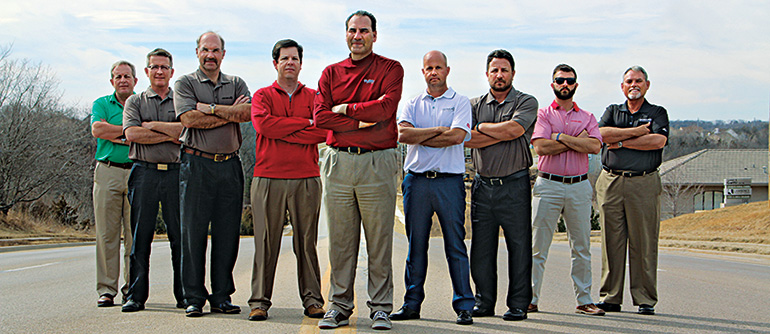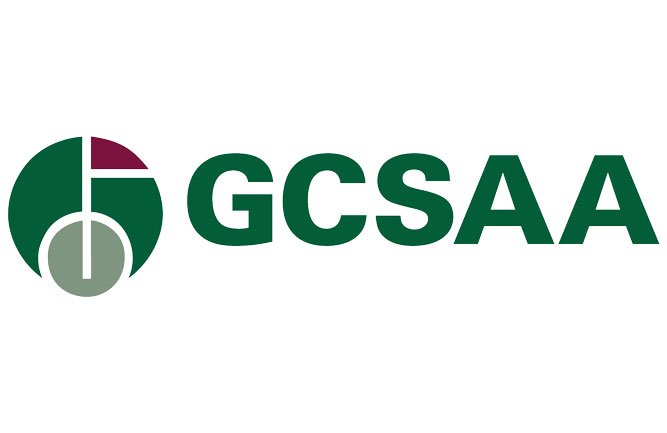Road Warriors: What the GCSAA field staff program means to chapters
These nine men comprise the GCSAA’s field staff program. Their mission: to help GCSAA chapters, big and small, across the nation. But can any program be everything to everyone?

(Left to right) Ron Wright, David Phipps, John Miller, Kevin Doyle, Steve Randall, Jeff Jensen, Ralph Dain, Chase Rogan and Brian Cloud make up GCSAA’s field staff team, pictured in Lawrence, Kan., last month. Photo: GCSAA
It’s about a 600-mile trek from Dallas/Fort Worth to Lajitas, Texas.
“I drove it earlier this month. It’s on the border of Texas and Mexico. That distance is probably my limit,” says Brian Cloud, GCSAA’s field staffer for the South Central region, which includes all of Texas, New Mexico, Oklahoma and Arkansas. “It took four days to do it (round-trip). I’ve got enough windshield time, if this ever falls through, I can be a truck driver.”
David Phipps, field staff for the Pacific Northwest, is servicing an area that stretches as far northwest as Alaska, and as far southeast as Colorado. At this moment, he’s driving home to Oregon City, Ore., after attending the Western Washington GCSA chapter meeting at Inglewood GC in Kenmore, Wash.
It’s typically a three-hour drive. Unless he’s stuck in traffic in Seattle, as he is now.
“People ask me if I mind (the travel). It’s part of my job, it’s what I signed up for,” Phipps says over a crackling cell phone connection. “I wouldn’t have taken the job if I wasn’t comfortable with it.”
It’s an especially busy travel time of year for Phipps and his eight colleagues on the field staff team. Ask him where he’s been in this prolonged winter and he starts rattling off the locations: there was the Golf Industry Show in Orlando; the Colorado Golf Summit; the Canadian Turfgrass Show; a visit to GCSAA headquarters in Lawrence, Kan.; Lewiston, Idaho; and a speaking engagement in San Diego.
Oh! And then there was Missoula. How could he forget beautiful Missoula, Mont.?
“Things fly,” Phipps laughs.
Especially GCSAA’s field staffers.
Accomplishing the ‘we’
With the October 2013 hiring of Ron Wright, CGCS, as the field staffer for the Southeast region, the team is now complete. Nine field staff covering nine regions. Nine field staff to… do what, exactly?
According to GCSAA.org, the purpose of the field staff program is to “help chapters utilize GCSAA programs and services to a fuller extent.”
“Ultimately we are working to accomplish the ‘we’ between chapters, GCSAA and allied organizations,” says Steve Randall, associate director of chapter outreach for GCSAA and the leader of the field staff team. “We’re trying to get rid of that ‘us vs. them’ (perception). I’ve enjoyed seeing a chapter come from bare-bones offerings and services to ultimately being very engaged with what GCSAA offers. We’ve been able to facilitate and provide tools to assist them to be successful. That is the essence of this program.”
But what about the chapters that aren’t ‘bare-bones?’ The chapters that are already fully engaged and familiar with what GCSAA has to offer?
“I like using the phrase that ‘we’re different things to different chapters,’” says Cloud. “Some chapters, we’re helping them check in people and doing simple things, and for some chapters we’re setting up a state golf day.”
Kevin F. Doyle, a former superintendent and now field staffer for the Northeast Region, says that trying to be different things to different chapters is his biggest professional challenge.
“I deal with 16 chapters and there are 16 individual and distinct cultures among those chapters. They require different resources, they have different strengths and weaknesses,” he says. “For us to be able to deliver what they need and what they’re looking for… takes a lot of time and effort.”
Visa or MasterCard?
The field staff program has been well received by GCSAA members, says GCSAA President Keith Ihms, CGCS.
“As a whole, we’ve had positive feedback. We’re trying to help chapters — I think we’ve done a pretty good job with that,” Ihms says. “Information is going out from headquarters, but more importantly, our staff gets a lot more input from the local chapters.”
“The field staff bring GCSAA closer to their members as another service tool,” says Lori Russell, executive director of the Peaks & Prairies GCSA. “We are fortunate as our chapters already had a good relationship with GCSAA through active members and even GCSAA board members, but the field staff is an added bonus — it makes GCSAA present in a valuable way.”
One chapter that counts the field staff among its best GCSAA member benefits is the Intermountain GCSA, which comprises Utah, southwest Wyoming and a small area of Nevada. Their membership is 220, with 120 superintendent members.
“We’ve been a struggling association,” says T. A. Barker, president of the chapter and the Class A superintendent of Fore Lakes GC in Taylorsville, Utah. “We’ve taken full advantage of this program, and it’s put us back on track.”
Barker thinks back to only a few years ago when he made a $10,000 charge on his personal credit card to cover the expense of the chapter’s annual meeting — a move that was not popular with his wife. “I almost got cut that day,” he laughs.
That day the Intermountain had no money to write a check. Today they have $50,000 at their disposal.
“David Phipps and Steve Randall flew out here and sat down with us and our board of directors and had a strategic planning meeting with us,” Barker says. “We’re running this chapter more as a business now. And it feels like GCSAA cares more about their chapters than they did before.”
Stealing from the rich
A smaller chapter like the Intermountain has certainly seen the benefit of the field staff, but what about it’s larger brethren?
Just to the east, in Colorado, Gary Leeper, executive director of the Rocky Mountain GCSA, says his chapter sees little benefit in the field staff program.
“For the budget, that money could be used other places to benefit all members. I believe that the field staff only benefits smaller chapters. Chapters such as the RMGCSA, their membership dues are paying for other chapters to benefit from field staff,” he says. “The only thing I’ve seen different from the field staff is we get a list of GCSAA members who have not renewed and visibility at some of our RMGCSA hosted events. That’s about all I can think of.”
Leeper, who owns an association management company and has been the executive director of the RMGCSA for a dozen years, says the Rocky Mountain has been one of the stronger affiliated chapters of GCSAA. Their numbers typically hover around 600 members.
Leeper says he is not sure the regional field staff is the correct direction to strengthen chapters. He believes the way to make chapters stronger is to consolidate the number of chapters, taking some of the smaller ones and bringing them under the umbrella of the larger, better-financed chapters.
Defining expectations
Ihms agrees that the program is a work-in-progress. He also says that, though it won’t happen on his watch, he wouldn’t be surprised to see the field staff team grow in upcoming years.
“I can really see us utilizing this position better. Right now, we have one person in a region, it’s a challenge for that person to get around to all of the board meetings,” Ihms says. “They could be involved in more detail in government relations issue… in getting new members. Just think about those few things, which is really in the scope of what we’d like them to be doing now… but it’s physically impossible for one individual to do that.”
Leeper, however, says that he and other chapter leaders need a clear picture of the objectives of the field staff program in order to better judge it.
“I’m not really sure what their role is. How can I evaluate them, how can GCSAA evaluate them if we don’t even know what they’re supposed to be doing?” he says. “Could we use those same dollars to strengthen chapters and create branding and promotional opportunities locally? I think so.”
Moving in the right direction
Even though Seattle traffic is at a standstill, Phipps still feels like things are moving in the right direction. At the Western Washington meeting, a great discussion was held on cool season pythium, which is currently ravaging greens in the area.
“Guys are flat-out losing their greens,” says the former superintendent, and winner of GCSAA’s 2011 President’s Award for Environmental Stewardship. “The joke around up here is the best sprayer up here is a sod cutter!”
Phipps is finishing a streak of seven weeks with trips.
“The neat thing is meeting people, and the stories they share. You develop friendships. It’s no longer a handshake, it’s a shoulder-slap,” he says. “I then get to share information from chapter to chapter. Helping superintendents do their jobs better — it’s a goal I have.”
The previous week, all nine field staffers were sitting together in the GCSAA auditorium — one of three times a year they all are in the same city. Ralph Dain, the original GCSAA field staffer, based in the golf hotbed that is Florida, doesn’t hesitate to say that these last six years have been the most rewarding of his career. He wanted the job so badly, he says, that following his interview at GCSAA headquarters, he stopped at a nearby church and got down on his knees and prayed.
Cloud ponders the many ways he’s been involved with the GCSAA. Since 1980, he’s been involved with GCSAA as a student, an assistant, a superintendent, a vendor, a chapter executive and now as an employee.
“I’ve seen this association from every aspect, with the exception of serving on the board, that exists,” he says. “I don’t want to sound corny, but it was a dream come true to be a part of an organization that I had been involved with since I was a student. I just felt so proud and honored.”
That doesn’t mean the job is easy.
“We’re still explaining our purpose,” he says. “Chapters weren’t real sure at the beginning, if we were spying on them, or what.
“Now they understand that we’re not threatening in any way… We’re a resource.”
Pulse of the nation
We asked all nine GCSAA field staffers the same question: What is the biggest concern at this moment for your region? Here are a few of their answers.
“This winter has quite a few facilities nervous about the potential for winterkill in bermudagrass stands. Many courses have recently converted to bermudagrass on the greens and along comes the coldest winter in 30 years. I think most of the greens will be ok since many facilities cover their greens. What people aren’t talking about are the fairways and rough, which do not get covered. A second slam from the winter is reduced revenue. One course I visited said that January 2014 was down 60 percent to the previous worst January in terms of revenue due to total club closure, power outages and a snow-covered course.”
Ron Wright, CGCS, Southeast Region
“Access to reliable and affordable water sources. As has been stated by many, ‘water is the new oil,’ and the ability of courses to conserve water and absorb rising rates will be critical to the game’s future success in the region. It’s paramount that the entire industry work together and proactively approach water agencies, municipalities and regulators to tell golf’s side of the story.”
Jeff Jensen, Southwest Region
“The biggest issue in Florida right now is the proliferation of local fertilizer ordinances calling for measures above and beyond the FDEP Model Ordinance. These measures call for fertilizer blackout periods extending from June until October. So far the Golf BMP manual has been successful in keeping golf exempt, but the comment is frequently made by our opposition that golf is next…”
Ralph Dain, Florida Region
“For the Great Lakes Region, the thought on most superintendents’ minds is the winter and ice damage and for the public facilities, it is how the prolonged winter will affect the bottom line.”
John Miller, CGCS, Great Lakes Region











